Effects of Multipath Attenuation in the Optical Communication-Based Internet of Underwater Things
Abstract
1. Introduction
- We designed a unified system model that accommodates channel loss due to multiple scattering and characterized its respective performances in terms of magnitude response for different system configurations (FoVs, apertures) and water types (clear ocean, coastal, and turbid harbor).
- We proposed a Monte Carlo-based statistical model that utilizes a discrete histogram of the total received power to characterize temporal dispersion.
- Based on our model, the respective BER and magnitude responses resulting from the temporal dispersion under different FoVs, apertures, and water types are simulated and presented.
2. Related Work
Motivation
3. Propagation Model
3.1. Model Requirements
- no shift in frequencies of the incident and scattered light is considered, the only change that is considered is the change in direction;
- the phase functions are used to measure the anisotropy of scattering;
- scattering and absorption are uniform throughout the channel;
- the boundaries are absolutely absorbing, and any photon traveling past the receiver or transmitter plane is marked as terminated.
- the photon’s initial conditions,
- light transport under water, and
- photon reception.
3.1.1. Photon Initial Conditions
3.1.2. Light Transport Underwater
3.1.3. Photon Reception
- Photon’s remaining weight/power is negligibly small, in which case the weight is rouletted [25].where is the weight after scattering, and is the old weight. R is the uniform random variable in the interval [0, 1], and is the roulette threshold. If R is less than the fraction , then the old weight is scaled roulette threshold times, and if it is greater than the fraction, the weight tends to zero which means the photon is completely absorbed. This method limits the number of computations and also preserves the total probability.
- If the photon hits a boundary other than the air–water interface (in such case the photon continues to propagate), it is terminated.
3.2. Temporal Response of the Channel
Discrete Histograms and Their Respective Bin Widths
4. Simulation Results
4.1. Magnitude Response
4.2. BER Performance
4.3. Photon Propagation Distance
5. Discussion
- The increase in transmission distance and scattering events increase multipath attenuation.
- Greater scattering and diffusivity of the optical source spreads the received optical power, thus causing temporal dispersion.
- In harbor water, the temporal dispersion is significantly high, and it also affects the data transmission at longer distances.
- A wider aperture and FoV increases received power gains, especially in the ocean and coastal water; however, the effect of FoV alone on overall BER performance is almost negligible in all water types.
- FoV and aperture of an optical wireless communication system underwater are independent of each other; altering one does not necessarily affect the other.
6. Conclusions
Author Contributions
Funding
Acknowledgments
Conflicts of Interest
References
- Kao, C.C.; Lin, Y.S.; Wu, G.D.; Huang, C.J. A comprehensive study on the internet of underwater things: Applications, challenges, and channel models. Sensors 2017, 17, 1477. [Google Scholar] [CrossRef] [PubMed]
- Wang, Z.; Shi, X.; Wang, J.; Gao, F.; Li, J.; Guo, M.; Zhao, H.; Qiu, S. Swimming Motion Analysis and Posture Recognition Based on Wearable Inertial Sensors. In Proceedings of the 2019 IEEE International Conference on Systems, Man and Cybernetics (SMC), Bari, Italy, 6–9 October 2019; pp. 3371–3376. [Google Scholar]
- Camomilla, V.; Bergamini, E.; Fantozzi, S.; Vannozzi, G. Trends supporting the in-field use of wearable inertial sensors for sport performance evaluation: A systematic review. Sensors 2018, 18, 873. [Google Scholar] [CrossRef] [PubMed]
- Cardia, C.; Gjanci, P.; Petrioli, C.; Saturni, G.; Spaccini, D.; Tomaselli, D. The Internet of Underwater Things: From Nemo to Underwater Whatsapp. In Proceedings of the Twentieth ACM International Symposium on Mobile Ad Hoc Networking and Computing, Catania, Italy, 2–5 July 2019; pp. 409–410. [Google Scholar]
- Shaikh, S.F.; Hussain, M.M. Marine IoT: Non-invasive wearable multisensory platform for oceanic environment monitoring. In Proceedings of the 2019 IEEE 5th World Forum on Internet of Things (WF-IoT), Limerick, Ireland, 15–18 April 2019; pp. 309–312. [Google Scholar]
- Kos, A.; Umek, A. Wearable sensor devices for prevention and rehabilitation in healthcare: Swimming exercise with real-time therapist feedback. IEEE Internet Things J. 2018, 6, 1331–1341. [Google Scholar] [CrossRef]
- Hagema, R.M.; Haelsig, T.; O’Keefe, S.G.; Stamm, A.; Fickenscher, T.; Thiel, D.V. Second generation swimming feedback device using a wearable data processing system based on underwater visible light communication. Procedia Eng. 2013, 60, 34–39. [Google Scholar] [CrossRef]
- Wei, Z.; Mu, X.; Fu, H. Wearable Full-Duplex Digital Transceiver for Underwater Optical Wireless Communications. In Proceedings of the 2018 Conference on Lasers and Electro-Optics Pacific Rim (CLEO-PR), Hong Kong, China, 29 July–3 August 2018; pp. 1–2. [Google Scholar]
- Sahu, S.K.; Shanmugam, P. A theoretical study on the impact of particle scattering on the channel characteristics of underwater optical communication system. Opt. Commun. 2018, 408, 3–14. [Google Scholar] [CrossRef]
- Qadar, R.; Kasi, M.K.; Ayub, S.; Kakar, F.A. Monte Carlo—Based channel estimation and performance evaluation for UWOC links under geometric losses. Int. J. Commun. Syst. 2018, 31, e3527. [Google Scholar] [CrossRef]
- Jasman, F.; Green, R.J.; Leeson, M.S. Impact of receiver field of view on underwater optical wireless communications. Microw. Opt. Technol. Lett. 2017, 59, 837–840. [Google Scholar] [CrossRef]
- Cochenour, B.; Mullen, L.; Muth, J. Temporal response of the underwater optical channel for high-bandwidth wireless laser communications. IEEE J. Ocean. Eng. 2013, 38, 730–742. [Google Scholar] [CrossRef]
- Cochenour, B.; Dunn, K.; Laux, A.; Mullen, L. Experimental measurements of the magnitude and phase response of high-frequency modulated light underwater. Appl. Opt. 2017, 56, 4019–4024. [Google Scholar] [CrossRef] [PubMed]
- Almabouada, F.; Abreu, M.A.; Coelho, J.M.; Aiadi, K.E. Experimental and simulation assessments of underwater light propagation. Front. Optoelectron. 2019, 12, 405–412. [Google Scholar] [CrossRef]
- Cochenour, B.; Laux, A.; Mullen, L. Temporal dispersion in underwater laser communication links: Closing the loop between model and experiment. In Proceedings of the Underwater Communications and Networking Conference (UComms), Lerici, Italy, 30 August–1 September 2016; pp. 1–5. [Google Scholar]
- Cochenour, B.M.; Mullen, L.J.; Laux, A.E. Characterization of the beam-spread function for underwater wireless optical communications links. IEEE J. Ocean. Eng. 2008, 33, 513–521. [Google Scholar] [CrossRef]
- Cochenour, B.; Mullen, L.; Laux, A. Spatial and temporal dispersion in high bandwidth underwater laser communication links. In Proceedings of the MILCOM 2008—2008 IEEE Military Communications Conference, San Diego, CA, USA, 16–19 November 2008; pp. 1–7. [Google Scholar]
- Jaruwatanadilok, S. Underwater wireless optical communication channel modeling and performance evaluation using vector radiative transfer theory. IEEE J. Sel. Areas Commun. 2008, 26, 1620–1627. [Google Scholar] [CrossRef]
- Zhang, H.; Dong, Y. General stochastic channel model and performance evaluation for underwater wireless optical links. IEEE Trans. Wirel. Commun. 2016, 15, 1162–1173. [Google Scholar] [CrossRef]
- Gabriel, C.; Khalighi, M.A.; Bourennane, S.; Leon, P.; Rigaud, V. Channel modeling for underwater optical communication. In Proceedings of the GLOBECOM Workshops (GC Wkshps), Houston, TX, USA, 5–9 December 2011; pp. 833–837. [Google Scholar]
- Li, J.; Gao, G.; Xu, C.; Bai, J.; Guo, Y. Influence of Temporal Dispersion on the Undersea Wireless Optical Communication and Its Mitigation using MLSE. In Proceedings of the OCEANS 2018 MTS/IEEE Charleston, Charleston, SC, USA, 22–25 October 2018; pp. 1–5. [Google Scholar]
- Hanson, F.; Radic, S. High bandwidth underwater optical communication. Appl. Opt. 2008, 47, 277–283. [Google Scholar] [CrossRef] [PubMed]
- Petzold, T.J. Volume Scattering Functions for Selected Ocean Waters; Technical Report; Scripps Institution of Oceanography La Jolla Ca Visibility Lab: La Jolla, CA, USA, 1972. [Google Scholar]
- Leathers, R.A.; Downes, T.V.; Davis, C.O.; Mobley, C.D. Monte Carlo Radiative Transfer Simulations for Ocean Optics: A Practical Guide; Technical Report; Naval Research Laboratory: Washington, DC, USA, 2004. [Google Scholar]
- Wang, L.; Jacques, S.L. Monte Carlo Modeling of Light Transport in Multi-LAYERED Tissues in Standard C; Technical Report; The University of Texas, MD Anderson Cancer Center: Houston, TX, USA, 1992. [Google Scholar]
- Scott, D.W. On optimal and data-based histograms. Biometrika 1979, 66, 605–610. [Google Scholar] [CrossRef]
- Cox, W.; Muth, J. Simulating channel losses in an underwater optical communication system. JOSA A 2014, 31, 920–934. [Google Scholar] [CrossRef] [PubMed]
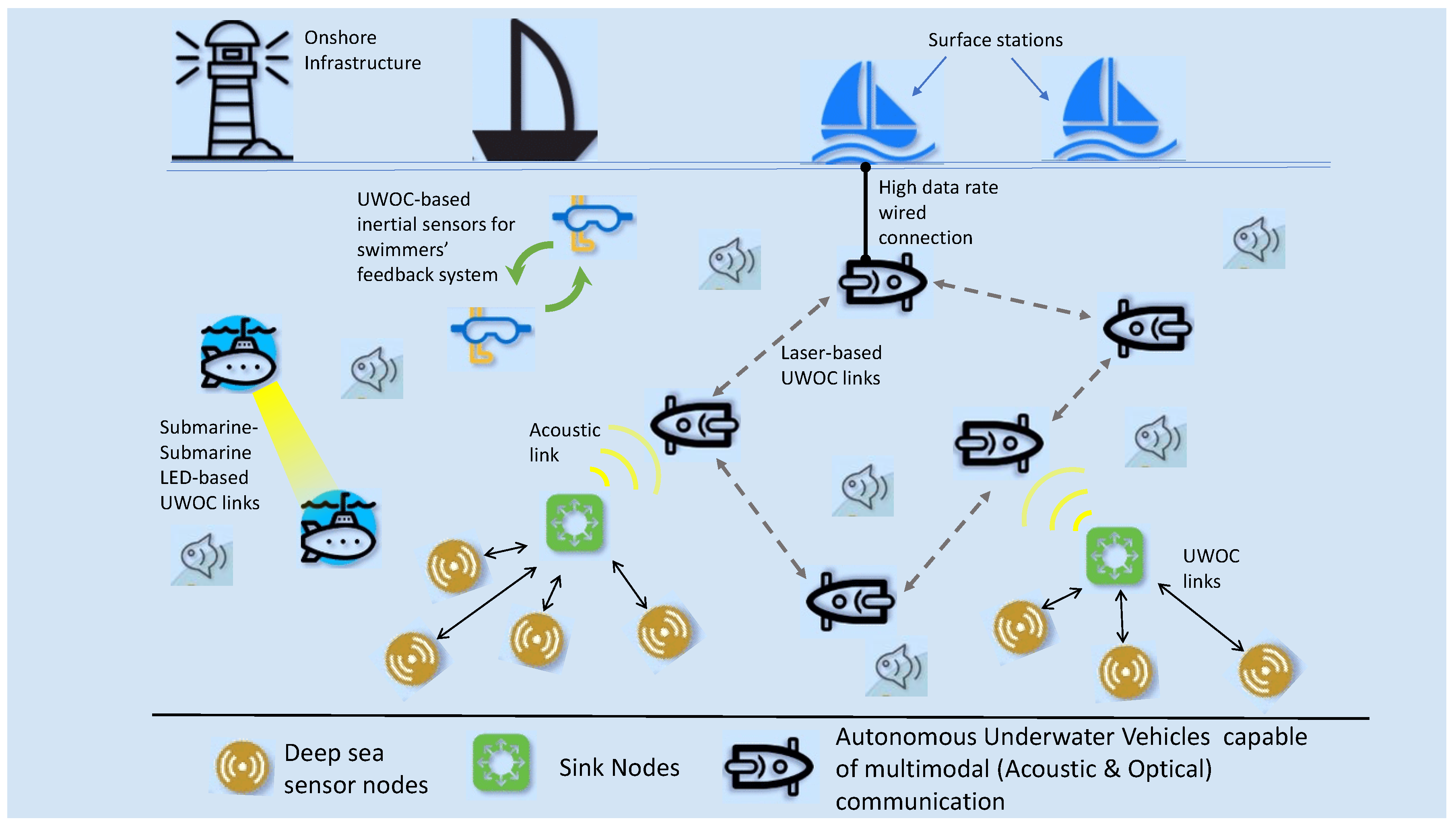

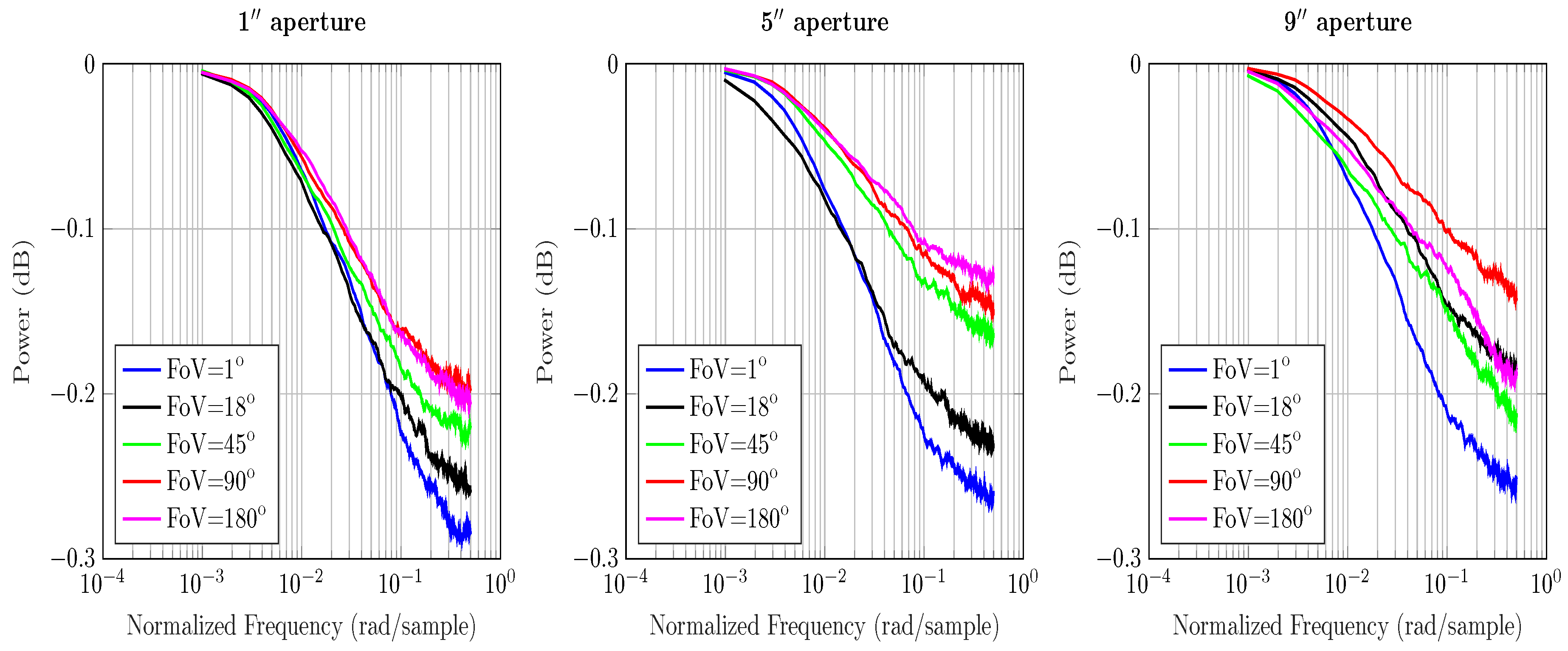
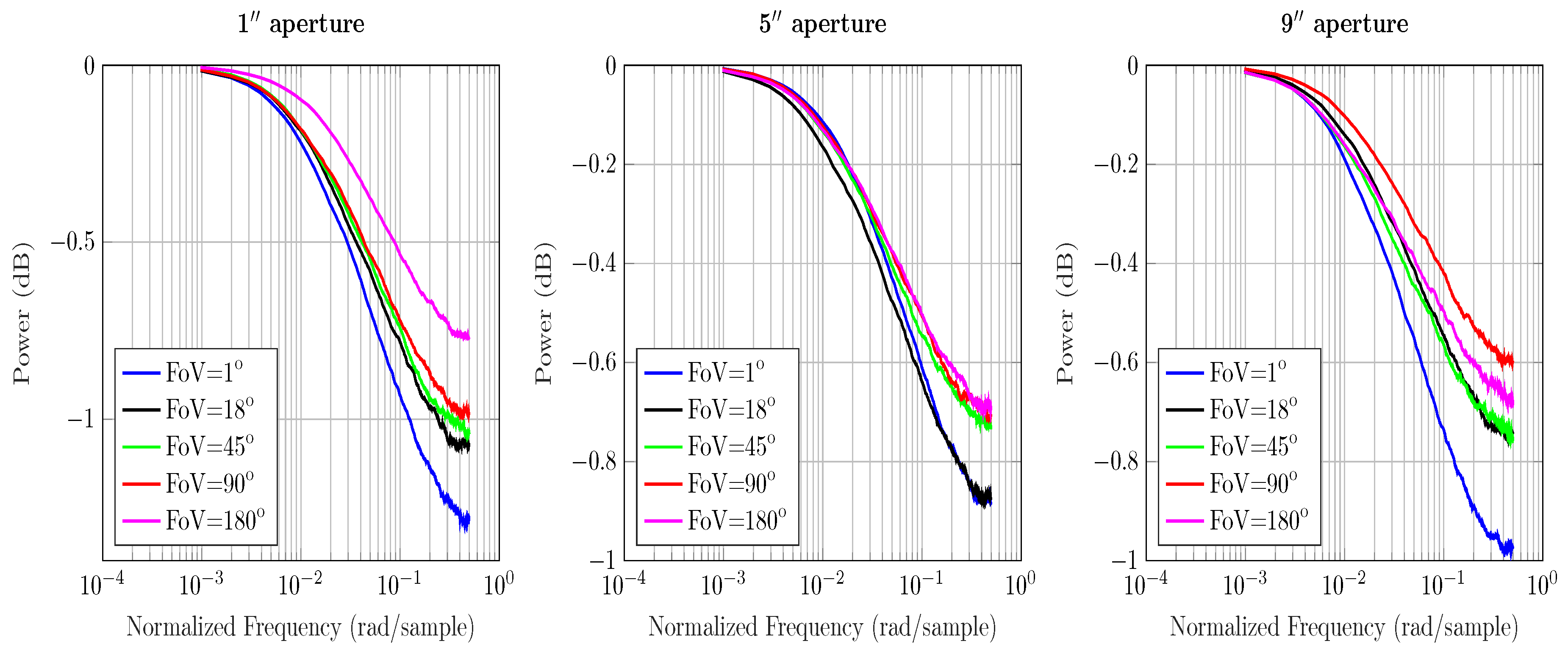

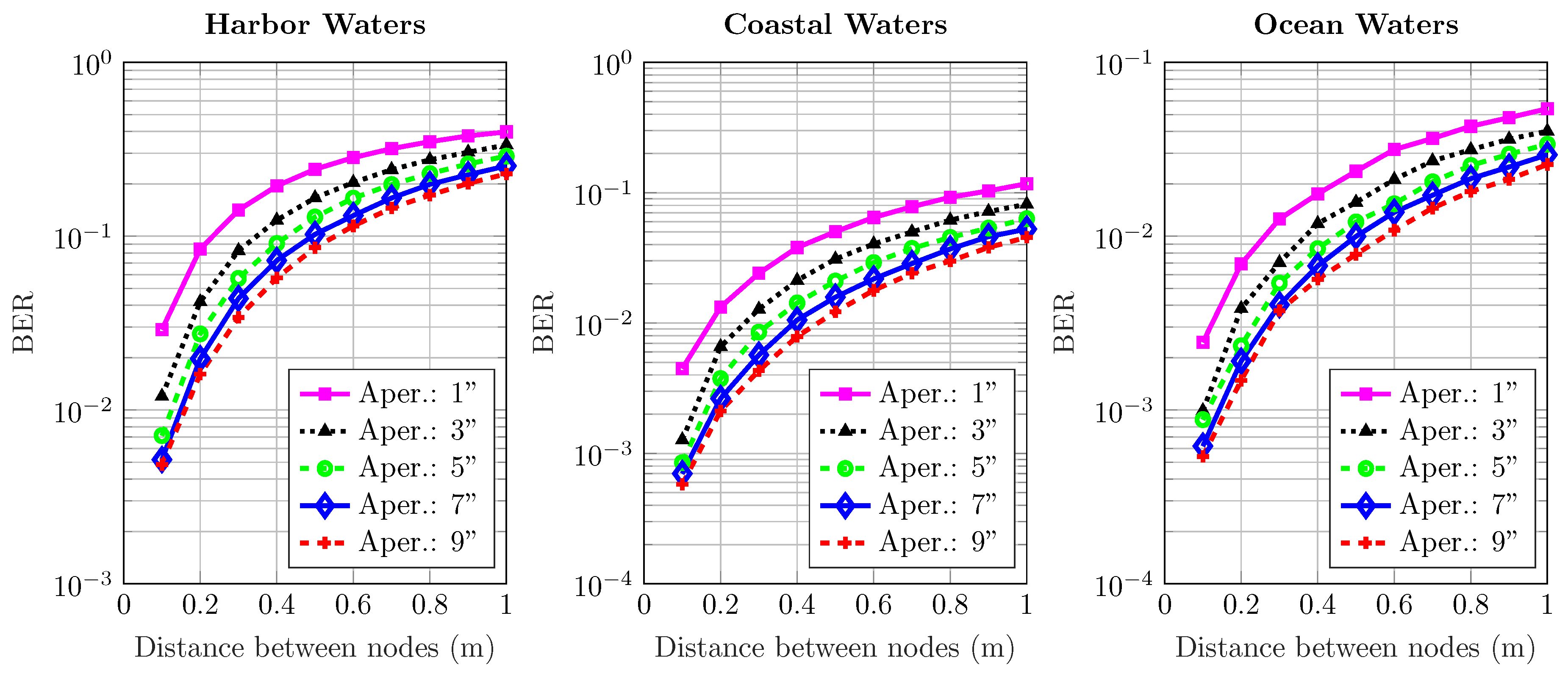



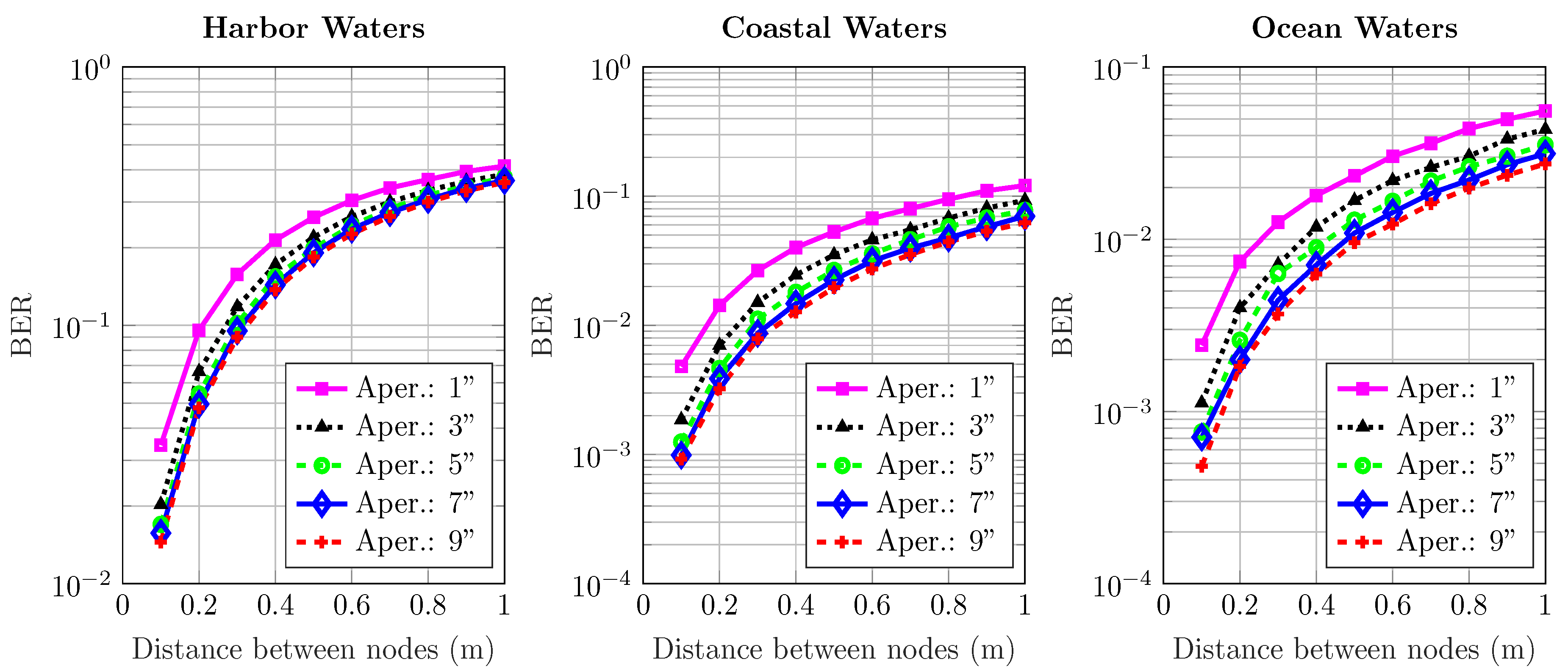

| Study Type | Advantages | Limitations |
|---|---|---|
| Simulation-based Modeling |
|
|
| Experimental Modeling |
|
|
| Analytical Modeling |
|
|
| Water Type | Attenuation Coefficient c | Water Albedo |
|---|---|---|
| Clear | 0.15 m | 0.25 |
| Coastal | 0.4 m | 0.55 |
| Harbor | 2.19 m | 0.83 |
| Coefficients | Symbol | Value |
|---|---|---|
| Half-angle beam divergence | mrad | |
| Beam waist | 1 mm | |
| Light source wavelength | 532 nm | |
| Link distance | d | 3 m |
| Water refractive index | 1.33 | |
| Field-of-views | FoV | 1, 18, 45, 90, 180 |
| Apertures | , , | |
| No. of evaluation points | n | 512 |
Publisher’s Note: MDPI stays neutral with regard to jurisdictional claims in published maps and institutional affiliations. |
© 2020 by the authors. Licensee MDPI, Basel, Switzerland. This article is an open access article distributed under the terms and conditions of the Creative Commons Attribution (CC BY) license (http://creativecommons.org/licenses/by/4.0/).
Share and Cite
Qadar, R.; Bin Qaim, W.; Nurmi, J.; Tan, B. Effects of Multipath Attenuation in the Optical Communication-Based Internet of Underwater Things. Sensors 2020, 20, 6201. https://doi.org/10.3390/s20216201
Qadar R, Bin Qaim W, Nurmi J, Tan B. Effects of Multipath Attenuation in the Optical Communication-Based Internet of Underwater Things. Sensors. 2020; 20(21):6201. https://doi.org/10.3390/s20216201
Chicago/Turabian StyleQadar, Rabia, Waleed Bin Qaim, Jari Nurmi, and Bo Tan. 2020. "Effects of Multipath Attenuation in the Optical Communication-Based Internet of Underwater Things" Sensors 20, no. 21: 6201. https://doi.org/10.3390/s20216201
APA StyleQadar, R., Bin Qaim, W., Nurmi, J., & Tan, B. (2020). Effects of Multipath Attenuation in the Optical Communication-Based Internet of Underwater Things. Sensors, 20(21), 6201. https://doi.org/10.3390/s20216201






